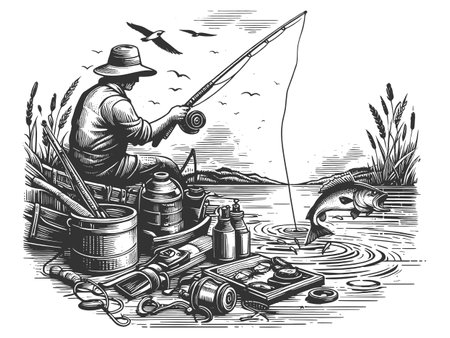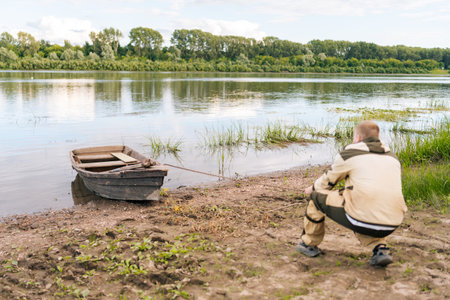Introduction to Non-Native Species in British Waters
When we speak of non-native species within British fishing, we refer to organisms that have been introduced, intentionally or otherwise, to waters outside their natural range. In the context of British angling, these are fish and aquatic invertebrates that did not historically inhabit the rivers, lakes, and coastal environments of the United Kingdom. Over centuries, a combination of human curiosity, sporting ambition, and commercial motives has led to the deliberate or accidental establishment of numerous species not originally found on these isles. Some introductions date back hundreds of years—such as the common carp, brought over by monks in the Middle Ages—while others are more recent, reflecting shifts in both global connectivity and angling fashion. Understanding the definition and historical context of non-native species provides essential groundwork for analysing their complex role in shaping British fishing culture, strategy, and ecology.
2. Notable Introductions and Their Historical Impact
The Arrival of Non-Native Species: A British Perspective
The tapestry of British fishing has been irrevocably shaped by the introduction of several non-native species, each with a unique backstory and influence on local waters. This section delves into the arrival of carp, zander, and rainbow trout—three prominent examples that have sparked debate and innovation among anglers across the UK.
Origins of Introduction
| Species | Origin | Period of Introduction | Reason for Introduction |
|---|---|---|---|
| Carp (Cyprinus carpio) | Continental Europe (originally East Asia) | 12th Century | Food source & ornamental purposes by monks and nobility |
| Zander (Sander lucioperca) | Central Europe | 1970s | Sport fishing enhancement in select freshwater venues |
| Rainbow Trout (Oncorhynchus mykiss) | North America (California) | Late 19th Century | Augmenting game angling & commercial stocking |
Early Perceptions Among Anglers and Stakeholders
The initial reception to these new arrivals was as varied as their origins. Carp, introduced by medieval monks, were valued both as a reliable food source and for their adaptability to estate ponds. By contrast, zander’s release in the Fens during the 1970s stirred controversy: traditionalists viewed them as voracious predators threatening native stocks, while progressive anglers welcomed the challenge they brought to coarse fishing. Rainbow trout, with their rapid growth and resilience, quickly became a staple in managed stillwaters, but purists often lamented their effect on indigenous brown trout populations.
Initial Effects on British Fisheries
| Species | Immediate Ecological Impact | Effect on Angling Culture |
|---|---|---|
| Carp | Became dominant in stillwaters; outcompeted native species in enclosed environments. | Pioneered modern specimen angling; led to the evolution of advanced tactics like hair rigs and bait innovations. |
| Zander | Altered predator-prey dynamics in certain waterways; concerns over predation on silver fish. | Sparked new predator-fishing techniques; increased popularity of lure and deadbait methods. |
| Rainbow Trout | Mild competition with native salmonids; hybridisation risks in some rivers. | Diversified fly-fishing venues; encouraged commercial fisheries catering to ‘put-and-take’ angling. |
Cultural Footprint: From Curiosity to Mainstay
The legacy of these introductions is evident today in Britain’s diverse fishing scene. While each species initially provoked scepticism or outright resistance, all three have become deeply woven into the fabric of British angling culture. Their presence continues to inspire debate regarding ecological balance versus sporting opportunity—a tension that remains at the heart of modern fisheries management and competitive strategy.

3. Ecological Consequences and Cultural Shifts
The introduction of non-native species into British waters has sparked profound ecological consequences, fundamentally altering the delicate balance of indigenous aquatic ecosystems. When species such as the zander, signal crayfish, and rainbow trout were first introduced—often with good intentions, such as enhancing sport fishing opportunities or controlling pest populations—their impact on local environments was underestimated. These newcomers frequently outcompeted native fish like the crucian carp and brown trout for food and habitat, resulting in notable declines in indigenous populations. Furthermore, predatory non-natives like the pike-perch (zander) have reshaped entire food webs, sometimes leading to cascading effects that extend beyond fish communities to aquatic plants and invertebrates.
In parallel with these ecological changes, there has been a marked shift in the cultural attitudes of British anglers. Traditionally, angling in Britain was steeped in a reverence for native species and localised watercraft knowledge. However, as non-native species became more prevalent—often providing exciting new challenges and trophy specimens—some sections of the angling community began to embrace these exotics. This has led to spirited debates within clubs and associations regarding stocking policies, conservation priorities, and what it means to be a traditional British angler.
Over time, awareness of the ecological costs associated with non-native introductions has grown. Conservation-minded anglers now champion catch-and-release practices for vulnerable natives and support eradication efforts against invasive species. Simultaneously, some fisheries have carved out niche reputations by specialising in non-natives, catering to a new breed of adventurous anglers keen on targeting species outside the traditional British canon. This duality reflects an ongoing negotiation between heritage and innovation in British fishing culture—a tension that continues to shape both policy decisions and everyday practice on the banks of Britains rivers and lakes.
4. Legislation and Fishery Management Strategies
The introduction and management of non-native species within British fisheries have compelled authorities, angling clubs, and conservationists to develop a nuanced approach in order to balance the often competing priorities of biodiversity, sporting interests, and ecological sustainability. Over the decades, legislative frameworks have been adapted to address new challenges as invasive species alter aquatic ecosystems.
Key Legislative Responses
British fishery legislation has evolved significantly since the 19th century. Early laws focused on protecting native stocks from over-exploitation, but recent statutes directly address the risks posed by non-native introductions. The Wildlife and Countryside Act 1981 stands as a keystone, making it illegal to release or allow the escape of certain species into the wild. Further controls were introduced through the Invasive Alien Species (Enforcement and Permitting) Order 2019, which harmonises UK policy with EU directives post-Brexit. These regulations are enforced by agencies such as the Environment Agency (EA) in England and Natural Resources Wales (NRW), who possess powers to fine or prosecute offenders and mandate removal or control measures.
| Legislation/Policy | Main Purpose | Implementing Authority |
|---|---|---|
| Wildlife and Countryside Act 1981 | Prevents release of listed non-native species | Environment Agency, NRW |
| Invasive Alien Species Order 2019 | Regulates possession, transport & release of invasive species | DEFRA, Environment Agency |
| Salmon & Freshwater Fisheries Act 1975 | Controls fish stocking & movement between waters | Environment Agency |
| Angling Club Byelaws | Localised restrictions on bait/fish transfer | Angling Clubs/Federations |
Fishery Management Tactics in Practice
At the ground level, fishing clubs and authorities employ several strategies to uphold these regulations while supporting vibrant angling communities. Risk assessments precede any proposed stocking of non-native species such as carp or zander; these evaluations consider ecological impact, disease transmission risk, and compatibility with local biodiversity plans.
Biodiversity versus Sporting Interests: A Delicate Balance
The British fishing community is renowned for its tradition of specimen hunting and match fishing—disciplines often reliant on healthy populations of both native and introduced fish. Thus, management strategies strive for equilibrium:
- Selective Stocking: Clubs may only introduce non-natives into closed waters where they cannot escape into rivers or canals.
- Biosecurity Protocols: Stringent cleaning of equipment between venues reduces cross-contamination risks.
- Habitat Restoration: Authorities restore spawning grounds for natives like barbel and dace alongside maintaining ‘carp lakes’ for sport anglers.
- Culling and Control: Where species like signal crayfish or catfish threaten native fauna, humane removal campaigns are sometimes necessary.
- Education Campaigns: Anglers receive guidance on identifying non-natives and reporting illegal releases to authorities.
The Strategic Outlook: Adaptive Management
The ongoing challenge is to remain responsive as new threats emerge—whether from climate change shifting species ranges or evolving angler preferences. Stakeholder engagement, continuous monitoring, and policy flexibility are therefore vital elements in safeguarding both the sporting legacy and ecological integrity of British fisheries for future generations.
5. Modern Angling Techniques for Non-Native Species
Specialist Tactics for Challenging Adversaries
The rise of non-native species in British waters has prompted a wave of innovation among the nation’s anglers. No longer content with traditional methods, today’s fishing community actively develops and refines specialist tactics tailored to the behaviour and habitat of these introduced fish. For example, targeting zander in the Fens or Midlands reservoirs now involves vertical jigging and drop shotting—approaches borrowed from European angling but adapted with British finesse. Similarly, the pursuit of signal crayfish, an invasive crustacean, sees anglers deploying collapsible traps and baited hand-lines, often as part of local management schemes.
Tackle Innovations and Adaptations
Modern tackle reflects the need for precision and versatility when targeting non-native species. Lure fishing has surged in popularity, with compact spinning rods and ultra-light reels enabling effective targeting of species like perch and pike that have flourished following accidental introductions. Fluorocarbon leaders and wire traces are essential for predatory newcomers, while custom lures—often designed to mimic native prey—have become mainstays in tackle boxes. The use of fish finders and sonar technology is increasingly common on larger waters, allowing anglers to locate shoals and structure where non-natives congregate.
Strategic Approaches: Balancing Sport and Stewardship
British anglers face a unique balancing act: enjoying the sport provided by non-native species while helping to manage their spread. Catch-and-release policies are nuanced; some clubs encourage retention or dispatch of certain invasives like signal crayfish or wels catfish to mitigate ecological impact. Anglers often participate in “removal competitions,” using both traditional rod-and-line tactics and modern trapping techniques to reduce populations where necessary. The integration of scientific data—such as spawning times and migratory patterns—has also informed seasonal strategies, ensuring that efforts are effective and sustainable.
Reflecting Modern Trends: Community Collaboration and Digital Resources
The interconnectedness of Britain’s angling scene has fuelled rapid dissemination of best practices via online forums, YouTube tutorials, and dedicated social media groups. Local angling societies partner with environmental agencies to deliver workshops on identifying non-native species and using specialised gear responsibly. Mobile apps now help anglers log catches, map sightings, and report new populations—blending tradition with cutting-edge technology in a uniquely British context.
6. The Future Outlook for British Fisheries
As we reflect on the intricate history of non-native species in British fishing, it is clear that the landscape of angling and fisheries management continues to evolve at a rapid pace. Looking ahead, several key factors are poised to shape the future of British fisheries, from emerging ecological challenges to shifting cultural attitudes within the angling community.
Reflections on Long-Term Prospects
The long-term sustainability of British fisheries hinges upon a delicate balance between tradition and adaptation. The resilience shown by native fish populations in the face of historic introductions provides some hope, but ongoing pressures such as climate change and habitat alteration mean that continued vigilance is essential. The importance of scientific research, proactive legislation, and engagement with local angling clubs cannot be overstated when considering strategies for maintaining healthy and productive waters for generations to come.
Potential New Arrivals: A Double-Edged Sword
The arrival of new non-native species remains both a threat and an opportunity for British fishing. On one hand, novel introductions could disrupt established ecosystems and jeopardise local biodiversity; on the other, carefully managed additions might bolster angling opportunities or even support conservation efforts through controlled stocking programmes. However, lessons from the past stress the need for rigorous impact assessments before any new species are sanctioned for release into British waters.
Conservation Priorities: Protecting What Matters Most
Protecting indigenous fish stocks must remain at the forefront of fisheries management policy. This includes not only direct action against invasive threats but also broader habitat restoration projects and water quality improvements. Collaboration between government agencies, environmental organisations, and grassroots anglers will be vital in safeguarding rare native species such as the wild brown trout or the crucian carp—both icons of Britain’s rich fishing heritage.
The Continuing Evolution of British Fishing Culture
Ultimately, the future of British fishing will be shaped as much by cultural evolution as by ecological change. Anglers across the UK are increasingly embracing conservation-minded practices, from catch-and-release policies to citizen science initiatives monitoring river health. As awareness grows regarding both the fragility and resilience of Britain’s aquatic environments, so too does a sense of shared stewardship—a trend likely to define the next chapter in our nation’s storied relationship with its waterways.
In summary, while non-native species have left an indelible mark on British fishing history, it is our collective response to these changes that will determine what lies ahead. By blending respect for tradition with forward-thinking management strategies, British fisheries can continue to thrive amidst uncertainty—preserving not just fish stocks but also the unique cultural legacy that makes angling such an enduring passion across the United Kingdom.

